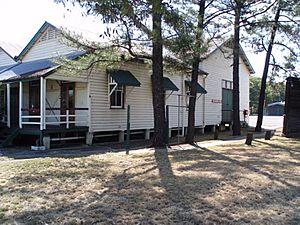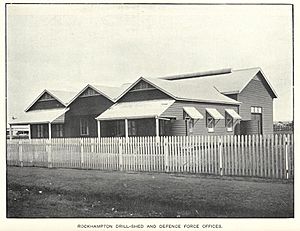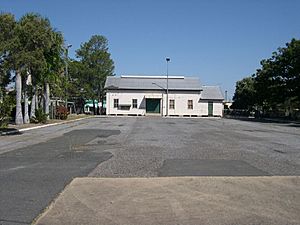Training Depot Drill Hall Complex, Rockhampton facts for kids
Quick facts for kids Training Depot Drill Hall Complex |
|
|---|---|

Former Training Depot Drill Hall
|
|
| Location | Archer Street, Rockhampton City, Rockhampton, Rockhampton Region, Queensland, Australia |
| Official name: Training Depot Drill Hall Complex (former) | |
| Type | state heritage (built) |
| Designated | 5 June 2007 |
| Reference no. | 602258 |
| Significant period | 1900s (fabric) 1906-1939 (historical use) |
| Lua error in Module:Location_map at line 420: attempt to index field 'wikibase' (a nil value). | |
The Training Depot Drill Hall Complex is an old military training site in Rockhampton, Queensland, Australia. It used to be a place where soldiers practiced and trained. This important historical site was added to the Queensland Heritage Register on June 5, 2007. This means it's protected because of its special history.
Contents
A Look Back: History of the Training Depot
The main drill hall at this site was built in May 1906. It was designed by the Queensland Government Architect's office. More parts were added to the southern side in 1937.
Later, in 1928, another drill hall and a wagon shed were moved here from Mount Morgan. A rifle range and a brick "Q Store" (a supply building) were also built by 1939. Even more buildings were added during and after World War II.
Early Days of Rockhampton
In the early 1850s, the Archer brothers were among the first to explore the Rockhampton area. They found it was good for raising animals. Rockhampton became a town in 1858.
When Queensland became a separate colony, it needed its own ways to protect itself. Britain's navy couldn't always be there. So, each colony started its own defence forces.
Queensland didn't have enough money or people for a big army. So, volunteer soldiers became very important. These volunteer groups started in 1860. They held training camps to practice together. This helped them become a strong fighting force.
Growing Defence Needs
In the late 1870s, there were worries about war. This led to changes in Queensland's defence plans. In 1884, a new law called the Defence Act was passed. This law completely changed how the colony was defended.
The volunteer system continued, but a permanent local force was also created. This force included paid soldiers and police rifle clubs. After 1884, many drill halls were built across Queensland. They were built in cities like Brisbane, Ipswich, and Rockhampton. About 30 halls were built by the early 1900s.
The Rockhampton Site
The training depot was built on a piece of land called Leichhardt Square. This square was originally a recreation area. In 1881, it became a temporary reserve for public use.
In 1901, the northern part of Leichhardt Square became a Defence Force Reserve. This was part of a national plan. Many defence sites were moved from state control to the new Australian Commonwealth government. In Rockhampton, land and buildings worth £4,526 were transferred. The "Drill Shed Reserve, Archer Park" was valued at £2,250.
Before Australia became a federation, the Queensland Defence Forces in Rockhampton used a site on Fitzroy Street. This site had a brick drill shed built in 1878. But it was too small for the growing number of soldiers. After the Archer Street site was created, the Fitzroy Street reserve was no longer used for defence.
Building the Drill Hall
Plans for the new drill hall and offices were made in May 1906. These plans included the drill hall, offices, water tank stands, and a fence. By 1911, an armoury (a place to store weapons) had also been built east of the drill hall.
The 42nd Battalion, Royal Queensland Regiment, used this depot for a long time. This battalion has a history in Rockhampton going back to 1884. They are known for their service in both world wars. Early leaders like Colonel DD Dawson and Brigadier-General William George Thompson were important figures.
Many other military groups also used the site. These included mounted infantry, light horse units, and various transport companies. Even cadets and the Air Training Corps used the depot.
Changes and Uses Over Time
Until April 1928, the drill hall, armoury, and toilets were the only buildings. Then, three more buildings were moved from Mount Morgan. These were another drill hall, a wagon shed, and another toilet. The moved drill hall and wagon shed are still on the property today.
In 1937, the original 1906 drill hall was made bigger. By 1943, the old armoury was replaced with a new building for washing and storage. A petrol/oil store was also built. The drill hall from Mount Morgan was used for offices and lectures. The wagon shed became a garage.
During World War II, the 1906 drill hall was a busy place. It was used for army medical checks and as a recruiting office. In the 1950s, young men had their medicals here for National Service. The open area outside, called the parade ground, was where soldiers gathered before going to camp. After the war, the drill hall was popular for parties and dances.
By 1939, a rifle range was also built. It was used for target practice with smaller bullets. This helped soldiers practice handling weapons. School cadets and even civilian clubs used the range until the late 1980s.
The 1906 drill hall served many purposes over the years. It was a supply store, an armoury, and offices for the battalion. It was also used as an officers' mess and a display area for military items. After 1939, formal military drilling was done on the parade ground, not inside the hall.
More buildings were added after the war, including homes for married soldiers. In October 2000, the 42nd Battalion moved to a new, larger site. The old training depot on Archer Street is now empty.
What the Training Depot Looks Like
The main drill hall is shaped like a square. From the front (Archer Street), it looks like three sections with pointed roofs. Behind these, the main drill hall has another pointed roof across it. It's a low building, sitting on concrete stumps. It has a corrugated iron roof and wooden walls. The front has exposed wooden frames and vertical wooden boards. There's a long covered porch along the western side.
Inside, the front and west parts of the building have offices. The walls and ceilings are mostly made of vertical wooden boards. Some walls are covered with plywood or fiberboard. The main drill hall area used to have an open roof, but now it has a fiberboard ceiling.
The floor in the hall is made of strong hardwood. The office areas have linoleum, carpet, or tiles.
Other Buildings and Features
The rifle range is about 25 meters long. At the far end, there's a backing board about eight meters wide and four meters high. It's made of two layers of wooden slats with gravel and earth packed between them. A metal plate for targets is at the bottom. It's next to the drill hall.
The other drill hall, moved from Mount Morgan, is on the eastern side. It's a rectangular building with a corrugated iron roof and plywood outside. It's used for offices and was once a sergeant's mess. Inside, it has a mix of original wooden walls and newer partitions. The original floor is hardwood.
The old store building was once the wagon shed from Mount Morgan. It's a rectangular shed with a pointed roof and corrugated iron walls over a wooden frame. It has no inside walls. Three large double doors on the western side let vehicles in. There are no windows. The floor is concrete, except for a small raised wooden section.
The former Q Store is in the north-east corner. It's a red brick building with a hip (sloping) corrugated iron roof. It has a small attic in the middle and a concrete floor. Inside, it's divided into three brick sections. Each section has large sliding double doors on both sides, leading to Alma Street and the depot yard.
Other buildings include an administration building, which was originally a home for married soldiers. It's a low building with a corrugated iron roof and hardiplank walls. Another former married quarters building is also used for administration.
The parade ground is a paved area about 60 by 30 meters. It was used for military parades and also for parking vehicles.
Why It's a Heritage Site
The former Training Depot Drill Hall Complex was added to the Queensland Heritage Register on June 5, 2007. This means it's considered very important to Queensland's history and culture.
Showing Queensland's History
The drill hall from 1906 is a great example of a military training building built after Australia became a nation. It shows how military training depots developed over time. You can see this in the way the drill hall and parade ground are designed.
A Rare Example
The 1906 drill hall is special because it's one of the oldest drill halls still standing in Queensland. Many other drill halls were built later, after 1911. This makes it a rare and important piece of history.
Key Features of Military Sites
Both the original drill hall and the one moved from Mount Morgan show what military drill halls were like. They had large open spaces for indoor training and offices. They were built using wood and corrugated iron, which was quick and cheap.
The other buildings, like the rifle range, the old married quarters, the wagon shed, and the Q Store, also show how the site was used. They help us understand what life was like for the soldiers who trained there.
Connection to the Community
The Department of Defence used this site for about 100 years. Many soldiers and service members trained here. This depot has a strong connection to the people who served and the community of Rockhampton.



